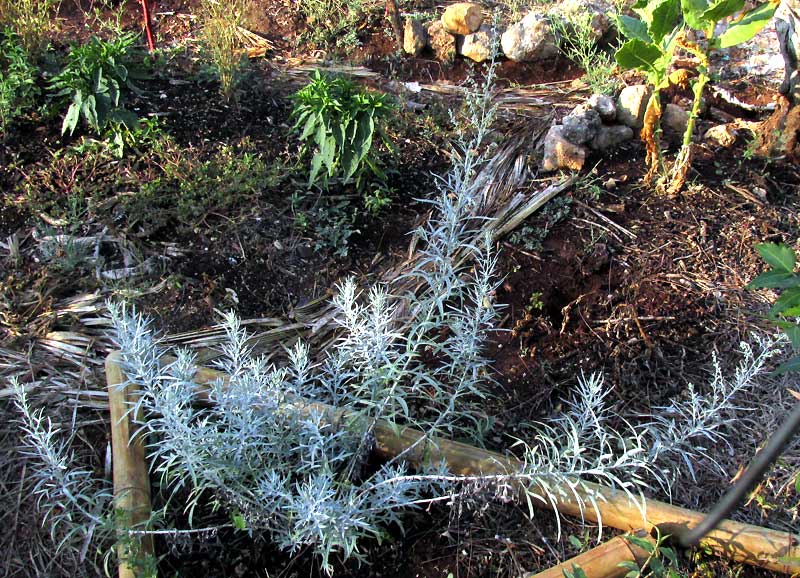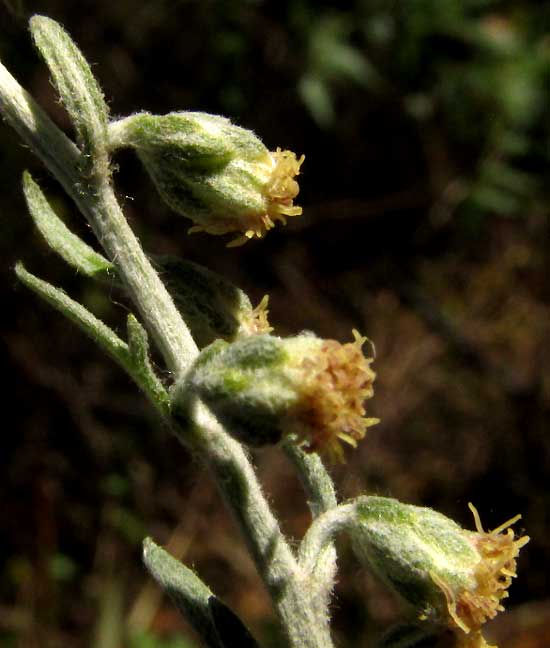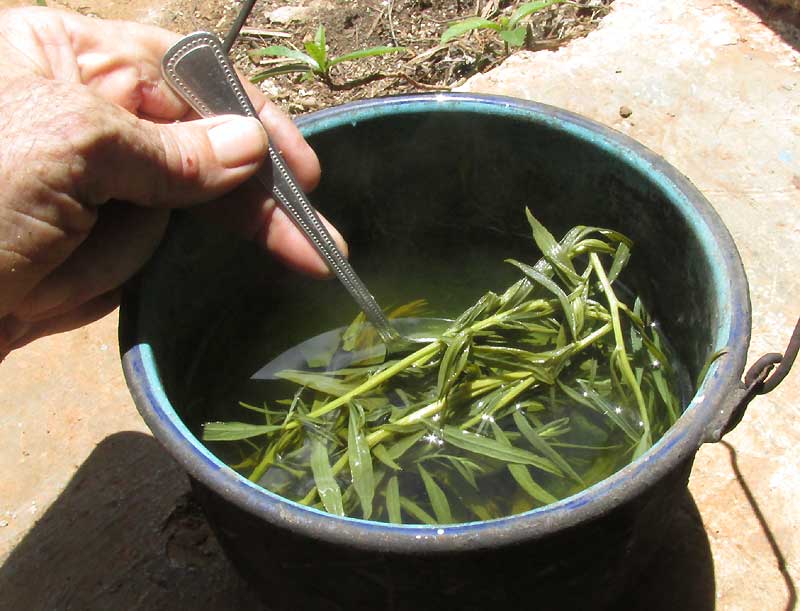Excerpts from Jim Conrad's
Naturalist Newsletter
from the April 27, 2019 Newsletter issued from Rancho Regensis north of Valladolid, Yucatán, MÉXICO;
elevation ~40m (~130 ft), N~20.876°, W~88.170°
MEDICINAL WHITE SAGE
Even today when the average Maya teenager walks around looking at cellphone screens, medicinal plants commonly are grown in people's backyards. A while back a sprig of one of the most frequently grown was given me, I planted it in my own little garden spot, and now it's about a meter tall (1 yard) and flowering, as shown below:

In that picture notice that the plant not only spreads, but -- as seen by a sprout emerging beyond the plant's bamboo bed margin on the right -- it issues underground rhizomes, which sprout along their length. This is a good field mark helping separate it from numerous look-alike species.
From the first the plant was easy to recognize as a kind of sage of the Sagebrush kind -- a species of the big genus Artemisia, of the huge Composite or Aster Family, the Asteraceae. Besides Sagebrush, other species of Artemisia may be referred to as wormwoods or mugworts, plus the popular garden herb known as Tarragon is an Artemisia species.
The small flowering heads arranged in slender panicles was typical of Artemisia species, as seen below:

Unlike flowering heads of most species in the Composite Family, individual flowering heads of Artemisia species bear no strap-shaped ray florets along the head's border, but rather only tiny, cylindrical disc flowers. These are crammed together within a cuplike involucre consisting of only a few rounded, white-hairy bracts, as shown below:

That dense mantle of cobwebby, white hairiness covers our plant's entire body, though the upper sides of leaves are less hairy, surely to encourage photosynthesis, as seen below:

The shape of that leaf is distinctive, too -- very deeply lobed, the lobes slender, and the leaves themselves often arising amid tufts of much smaller leaves.
Maybe the most revealing identification feature for the genus Artemisia, however, doesn't show in any of the above photos: the sage odor of the plant's crushed herbage.
A 2012 publication entitled El Huerto Familiar del Sureste de México ("The Family Garden of Southeastern Mexico"), edited by Ramón Mariaca Méndez, lists four Artemisia species grown for medicinal purposes: Artemisia absinthium, A. laciniata, A. ludoviciana and Artemisia mexicana.
Our plant is ARTEMISIA LUDOVICIANA, native to pine and oak forests of the Mexican highlands, north throughout much of North America, mainly the western and central parts. In fact, we've seen it in Texas, our page for it at www.backyardnature.net/n/h/whitsage.htm
There we call it White Sage, but it's known by several names, including Silver Sage, Silver Wormwood, Western Mugwort, Louisiana Wormwood, White Sagebrush and Gray Sagewort. The Texas plants display a few subtle differences from ours. Seven subspecies of Artemisia ludoviciana are recognized, ours being subsp. mexicana.
On our page for the Texas plant several traditional medicinal uses is given, but back when those plants were encountered I had no idea that here in the Yucatan, well beyond the species' native distribution, they'd be so highly regarded by the Maya for their curative power.
Mainly the Maya tell me that Artemisia ludoviciana is for upset stomach. However, there's a large body of literature citing many other uses. The , such as a page at the {now defunct} MedicinalPlants.US website. That page begins with reports about the plant by the earliest Spanish invaders in Mexico during the 1500s. In ends with recent findings that "... the ethanolic extract of the aerial parts is a potent and specific inhibitor of the transcription factor NF-kB," whatever that means. The page sums up the current attitude toward the medicinal value of Artemisia ludoviciana by saying that "The plant is regarded to possess spasmolytic and antihelmintic properties, but the experimental basis for this is insufficient."
I personally plan to make a tea of my plant's flowering head, to take advantage of its possible antihelmintic properties for my yearly flushing out of intestinal worms.
issued on August 26, 2019 from near the forest just west of Tepakán; elev. ~9m (~30 ft), N21.053°, W89.052°; north-central Yucatán state, MÉXICO
BREWING WHITE SAGE TEA
This week when I lost my appetite and felt a bit sick to the stomach, I did what the Maya do for an upset stomach: Over a campfire I made a hot sage "tea," using entire stems and leaves, as shown below.

Within moments my stomach felt better, though my appetite still hasn't returned. I fixed the tea three days in a row, trying to drink it on empty stomachs, and it seemed to make me feel better each time. I'm not sure that I've cured anything, but I'm convinced that nothing soothes an upset stomach more than a mug of steamy White Sage tea.